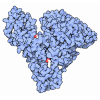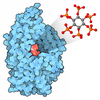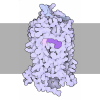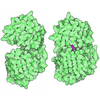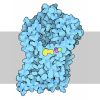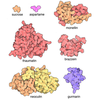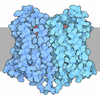[English] 日本語
 Yorodumi
Yorodumi- PDB-9iuc: Cryo-EM structure of human XPR1 in complex with InsP6 in closed s... -
+ Open data
Open data
- Basic information
Basic information
| Entry | Database: PDB / ID: 9iuc | ||||||||||||||||||||||||
|---|---|---|---|---|---|---|---|---|---|---|---|---|---|---|---|---|---|---|---|---|---|---|---|---|---|
| Title | Cryo-EM structure of human XPR1 in complex with InsP6 in closed state - in the presence of KIDINS220-1-432 without substrate KH2PO4 | ||||||||||||||||||||||||
 Components Components | Solute carrier family 53 member 1 | ||||||||||||||||||||||||
 Keywords Keywords | MEMBRANE PROTEIN / SLC53A1 / transporter / phosphate | ||||||||||||||||||||||||
| Function / homology |  Function and homology information Function and homology informationphosphate transmembrane transporter activity / phosphate ion transport / intracellular phosphate ion homeostasis / phosphate ion transmembrane transport / cellular response to phosphate starvation / inositol hexakisphosphate binding / efflux transmembrane transporter activity / response to virus / virus receptor activity / plasma membrane Similarity search - Function | ||||||||||||||||||||||||
| Biological species |  Homo sapiens (human) Homo sapiens (human) | ||||||||||||||||||||||||
| Method | ELECTRON MICROSCOPY / single particle reconstruction / cryo EM / Resolution: 3.8 Å | ||||||||||||||||||||||||
 Authors Authors | Zuo, P. / Liang, L. / Yin, Y. | ||||||||||||||||||||||||
| Funding support |  China, 1items China, 1items
| ||||||||||||||||||||||||
 Citation Citation |  Journal: Nat Commun / Year: 2025 Journal: Nat Commun / Year: 2025Title: Synergistic activation of the human phosphate exporter XPR1 by KIDINS220 and inositol pyrophosphate. Authors: Peng Zuo / Weize Wang / Zonglin Dai / Jiye Zheng / Shang Yu / Guangxi Wang / Yue Yin / Ling Liang / Yuxin Yin /  Abstract: Inorganic phosphate (Pi) is essential for life, and its intracellular levels must be tightly regulated to avoid toxicity. XPR1, the sole known phosphate exporter, is critical for maintaining this ...Inorganic phosphate (Pi) is essential for life, and its intracellular levels must be tightly regulated to avoid toxicity. XPR1, the sole known phosphate exporter, is critical for maintaining this balance. Here we report cryo-EM structures of the human XPR1-KIDINS220 complex in substrate-free closed and substrate-bound outward-open states, as well as an XPR1 mutant in a substrate-bound inward-facing state. In the presence of inositol hexaphosphate (InsP) and phosphate, the complex adopts an outward-open conformation, with InsP binding the SPX domain and juxtamembrane regions, indicating active phosphate export. Without phosphate or InsP, the complex closes, with transmembrane helix 9 blocking the outward cavity and a C-terminal loop obstructing the intracellular cavity. XPR1 alone remains closed even with phosphate and InsP. Functional mutagenesis shows that InsP, whose levels vary with Pi availability, works with KIDINS220 to regulate XPR1 activity. These insights into phosphate regulation may aid in developing therapies for ovarian cancer. | ||||||||||||||||||||||||
| History |
|
- Structure visualization
Structure visualization
| Structure viewer | Molecule:  Molmil Molmil Jmol/JSmol Jmol/JSmol |
|---|
- Downloads & links
Downloads & links
- Download
Download
| PDBx/mmCIF format |  9iuc.cif.gz 9iuc.cif.gz | 237.9 KB | Display |  PDBx/mmCIF format PDBx/mmCIF format |
|---|---|---|---|---|
| PDB format |  pdb9iuc.ent.gz pdb9iuc.ent.gz | 192.6 KB | Display |  PDB format PDB format |
| PDBx/mmJSON format |  9iuc.json.gz 9iuc.json.gz | Tree view |  PDBx/mmJSON format PDBx/mmJSON format | |
| Others |  Other downloads Other downloads |
-Validation report
| Summary document |  9iuc_validation.pdf.gz 9iuc_validation.pdf.gz | 1.4 MB | Display |  wwPDB validaton report wwPDB validaton report |
|---|---|---|---|---|
| Full document |  9iuc_full_validation.pdf.gz 9iuc_full_validation.pdf.gz | 1.4 MB | Display | |
| Data in XML |  9iuc_validation.xml.gz 9iuc_validation.xml.gz | 31.4 KB | Display | |
| Data in CIF |  9iuc_validation.cif.gz 9iuc_validation.cif.gz | 44.6 KB | Display | |
| Arichive directory |  https://data.pdbj.org/pub/pdb/validation_reports/iu/9iuc https://data.pdbj.org/pub/pdb/validation_reports/iu/9iuc ftp://data.pdbj.org/pub/pdb/validation_reports/iu/9iuc ftp://data.pdbj.org/pub/pdb/validation_reports/iu/9iuc | HTTPS FTP |
-Related structure data
| Related structure data | 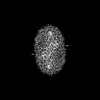 60897MC 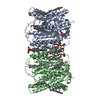 9ineC 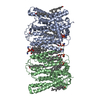 9infC 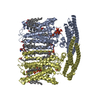 9inhC  9itgC M: map data used to model this data C: citing same article ( |
|---|---|
| Similar structure data | Similarity search - Function & homology  F&H Search F&H Search |
- Links
Links
- Assembly
Assembly
| Deposited unit | 
|
|---|---|
| 1 |
|
- Components
Components
-Protein , 1 types, 2 molecules AB
| #1: Protein | Mass: 82673.992 Da / Num. of mol.: 2 Source method: isolated from a genetically manipulated source Source: (gene. exp.)  Homo sapiens (human) / Gene: XPR1, SLC53A1, SYG1, X3 / Production host: Homo sapiens (human) / Gene: XPR1, SLC53A1, SYG1, X3 / Production host:  Homo sapiens (human) / References: UniProt: Q9UBH6 Homo sapiens (human) / References: UniProt: Q9UBH6 |
|---|
-Non-polymers , 5 types, 26 molecules 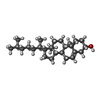
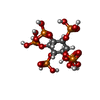
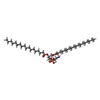
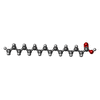
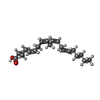




| #2: Chemical | ChemComp-CLR / #3: Chemical | #4: Chemical | ChemComp-3PE / #5: Chemical | ChemComp-PLM / #6: Chemical | |
|---|
-Details
| Has ligand of interest | Y |
|---|---|
| Has protein modification | Y |
-Experimental details
-Experiment
| Experiment | Method: ELECTRON MICROSCOPY |
|---|---|
| EM experiment | Aggregation state: PARTICLE / 3D reconstruction method: single particle reconstruction |
- Sample preparation
Sample preparation
| Component | Name: XPR1-KIDINS220-1-432 in complex with InsP6 without substrate KH2PO4 Type: COMPLEX / Entity ID: #1 / Source: RECOMBINANT |
|---|---|
| Source (natural) | Organism:  Homo sapiens (human) Homo sapiens (human) |
| Source (recombinant) | Organism:  Homo sapiens (human) Homo sapiens (human) |
| Buffer solution | pH: 7.5 |
| Specimen | Embedding applied: NO / Shadowing applied: NO / Staining applied: NO / Vitrification applied: YES |
| Vitrification | Cryogen name: ETHANE |
- Electron microscopy imaging
Electron microscopy imaging
| Experimental equipment |  Model: Titan Krios / Image courtesy: FEI Company |
|---|---|
| Microscopy | Model: FEI TITAN KRIOS |
| Electron gun | Electron source:  FIELD EMISSION GUN / Accelerating voltage: 200 kV / Illumination mode: SPOT SCAN FIELD EMISSION GUN / Accelerating voltage: 200 kV / Illumination mode: SPOT SCAN |
| Electron lens | Mode: BRIGHT FIELD / Nominal defocus max: 2000 nm / Nominal defocus min: 1500 nm |
| Image recording | Electron dose: 50 e/Å2 / Film or detector model: FEI FALCON IV (4k x 4k) |
- Processing
Processing
| EM software | Name: PHENIX / Category: model refinement | ||||||||||||||||||||||||
|---|---|---|---|---|---|---|---|---|---|---|---|---|---|---|---|---|---|---|---|---|---|---|---|---|---|
| CTF correction | Type: PHASE FLIPPING AND AMPLITUDE CORRECTION | ||||||||||||||||||||||||
| 3D reconstruction | Resolution: 3.8 Å / Resolution method: FSC 0.143 CUT-OFF / Num. of particles: 88082 / Symmetry type: POINT | ||||||||||||||||||||||||
| Refine LS restraints |
|
 Movie
Movie Controller
Controller






 PDBj
PDBj